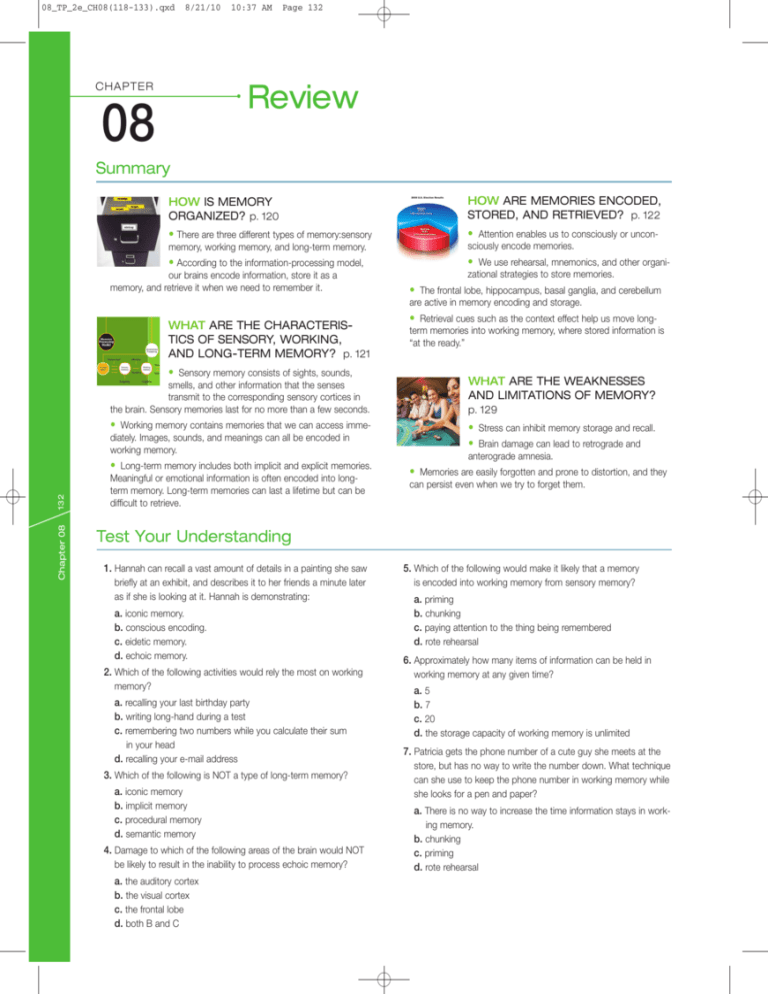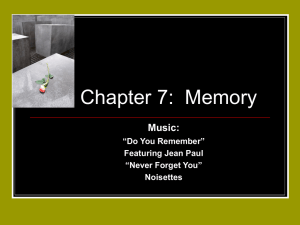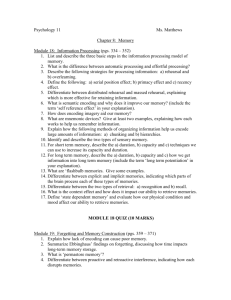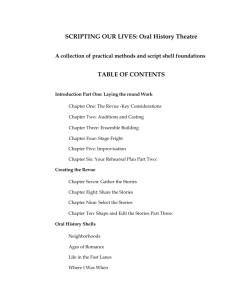Review - ThinkSpot
advertisement

08_TP_2e_CH08(118-133).qxd 8/21/10 10:37 AM CHAPTER Page 132 Review 08 Summary HOW IS MEMORY ORGANIZED? p. 120 • There are three different types of memory:sensory memory, working memory, and long-term memory. • According to the information-processing model, our brains encode information, store it as a memory, and retrieve it when we need to remember it. 2008 U.S. Election Results Obama 67.8% (365 electoral votes) McCain 32.2% (173 electoral votes) HOW ARE MEMORIES ENCODED, STORED, AND RETRIEVED? p. 122 • Attention enables us to consciously or unconsciously encode memories. • We use rehearsal, mnemonics, and other organizational strategies to store memories. • The frontal lobe, hippocampus, basal ganglia, and cerebellum are active in memory encoding and storage. WHAT ARE THE CHARACTERISTICS OF SENSORY, WORKING, AND LONG-TERM MEMORY? p. 121 • Sensory memory consists of sights, sounds, WHAT ARE THE WEAKNESSES AND LIMITATIONS OF MEMORY? • Working memory contains memories that we can access imme- • Stress can inhibit memory storage and recall. • Brain damage can lead to retrograde and • Long-term memory includes both implicit and explicit memories. 132 term memories into working memory, where stored information is “at the ready.” smells, and other information that the senses transmit to the corresponding sensory cortices in the brain. Sensory memories last for no more than a few seconds. diately. Images, sounds, and meanings can all be encoded in working memory. Chapter 08 • Retrieval cues such as the context effect help us move long- Meaningful or emotional information is often encoded into longterm memory. Long-term memories can last a lifetime but can be difficult to retrieve. p. 129 anterograde amnesia. • Memories are easily forgotten and prone to distortion, and they can persist even when we try to forget them. Test Your Understanding 1. Hannah can recall a vast amount of details in a painting she saw briefly at an exhibit, and describes it to her friends a minute later as if she is looking at it. Hannah is demonstrating: a. iconic memory. b. conscious encoding. c. eidetic memory. d. echoic memory. 2. Which of the following activities would rely the most on working memory? a. recalling your last birthday party b. writing long-hand during a test c. remembering two numbers while you calculate their sum in your head d. recalling your e-mail address 3. Which of the following is NOT a type of long-term memory? a. iconic memory b. implicit memory c. procedural memory d. semantic memory 4. Damage to which of the following areas of the brain would NOT be likely to result in the inability to process echoic memory? a. the auditory cortex b. the visual cortex c. the frontal lobe d. both B and C 5. Which of the following would make it likely that a memory is encoded into working memory from sensory memory? a. priming b. chunking c. paying attention to the thing being remembered d. rote rehearsal 6. Approximately how many items of information can be held in working memory at any given time? a. 5 b. 7 c. 20 d. the storage capacity of working memory is unlimited 7. Patricia gets the phone number of a cute guy she meets at the store, but has no way to write the number down. What technique can she use to keep the phone number in working memory while she looks for a pen and paper? a. There is no way to increase the time information stays in working memory. b. chunking c. priming d. rote rehearsal 8/21/10 10:37 AM Page 133 8. Aiden knows all of the U.S. state capitals. This is an example of: a. episodic memory. b. implicit memory. c. procedural memory. d. semantic memory. 9. Carla is taking a Calculus class. When her professor explains mathematical concepts to the class, he tells the students that the concepts won’t be on the exam and that the students don’t need to remember them. When Carla takes the exam, there is an extra credit question that asks students to list all of the mathematical concepts covered. Carla cannot remember any of them. She is exhibiting: a. cued forgetting. b. pseudoforgetting. c. the primacy effect. d. extinction. 10. Marco stops to get directions at a gas station. Unfortunately, after Marco leaves he realizes that he can only remember the first few turns, and has forgotten the rest of the directions. This is most likely an example of: a. the primacy effect. b. pseudoforgetting. c. cued forgetting. d. the recency effect. 11. In question 10, suppose Marco had instead forgotten the first part of the directions, but still remembered the last few street names the gas station attendant had told him. This would most likely be an example of: a. a semantic memory. b. an implicit memory. c. a procedural memory. d. an episodic memory. 13. Debbie has been driving a car for several years. Unlike when she first learned to drive, she can now control the car without thinking about which pedal to step on or how to turn the wheel. This is an example of: a. extinction. b. procedural memory. c. semantic memory. d. habituation. 14. Ashley is afraid to swim in lakes, and panics if she is in one. One summer, she decides to overcome her fear by putting a little more of her body in the lake each day. By the end of the summer she no longer feels afraid or panics when she swims in a lake. Ashley’s lack of fear by the end of the summer is an example of: a. extinction. b. cued forgetting. c. elaborative rehearsal. d. deep processing. 16. Students often remember the year of Christopher Columbus’ first voyage by reciting the rhyme, “In 1492, Columbus sailed the ocean blue.” This is an example of: a. extinction. b. a mnemonic. c. deep processing. d. chunking. 17. It is usually easier for people to memorize a list of words if they know the definitions of the words. One likely reason for this is: a. Shallow processing leads to better memory than deep processing. b. Deep processing leads to better memory than shallow processing. c. Implicit memories are easier recall than explicit memories. d. Explicit memories are easier recall than implicit memories. 18. If a person is in a bad mood when they study for an exam, they are likely to recall more of the information they studied if they are also in a bad mood when they take the exam. This is an example of: a. state-dependent memory. b. retroactive interference. c. long-term potentiation. d. the Yerkes-Dodson law. 19. Which of the following demonstrates proactive interference? a. Julie can only think of her current zip code when she tries to remember her old zip code. b. Patrick has a hard time remembering stories his mother told him as a child. c. Sheila can remember events from her past, but has difficulties creating new memories. d. A professor has trouble learning the names of his new students because he keeps confusing them with the names of his students from the previous semester. 20. Rebecca calls her mother to tell her she is going on vacation. Her mother said Rebecca already told her this. Rebecca is sure she didn’t, but knows she told her brother. What might Rebecca’s mother be experiencing? a. absent-mindedness b. misattribution c. bias d. persistence Remember to check www.thethinkspot.com for additional information, downloadable flashcards, and other helpful resources. Memory 12. When visiting his grandmother’s house, Benjy remembers the time he spilled grape juice on her carpet and then tried to clean it up with his grandmother’s good towels. This is an example of: a. taking a test b. being robbed at gunpoint c. playing an instrument you love d. seeing a movie with your favorite actor in it 133 a. the primacy effect. b. the recency effect. c. cued forgetting. d. pseudoforgetting. 15. Which of the following is most likely stored as a flashbulb memory? Answers: 1) c; 2) c; 3) a; 4) b; 5) c; 6) b; 7) d; 8) d; 9) a; 10) a; 11) b; 12) d; 13) b; 14) a 15) b; 16) b; 17) b; 18) a; 19) d; 20) b 08_TP_2e_CH08(118-133).qxd






